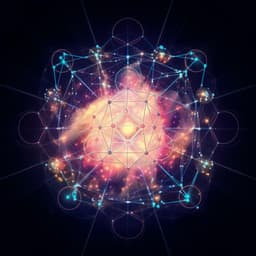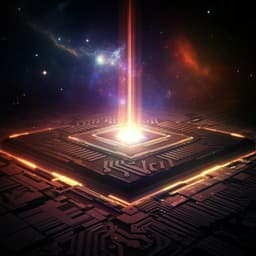
Physics
Quantum nonlinear spectroscopy of single nuclear spins
J. Meinel, V. Vorobyov, et al.
This groundbreaking research conducted by Jonas Meinel, Vadim Vorobyov, Ping Wang, Boris Yavkin, Mathias Pfender, Hitoshi Sumiya, Shinobu Onoda, Junichi Isoya, Ren-Bao Liu, and J. Wrachtrup introduces quantum nonlinear spectroscopy, which utilizes an entangled quantum sensor to measure fourth-order correlations of single nuclear spins, enabling the detection of distinct features in quantum systems undetectable by conventional methods. A new era for quantum sensing awaits!
Playback language: English
Introduction
The foundation of understanding any physical system lies in the statistics of measurements, specifically correlations or moments. These correlations are crucial for distinguishing various types of noise or fluctuations. Higher-order correlations hold particular importance as different physical quantities often exhibit similar first and second-order correlations. For instance, higher-order correlations of Gaussian noise factorize into first or second-order correlations, while those of symmetric dichotomous telegraph noise factorize into second-order correlations only in sequential partitions. Recent research has leveraged higher-order correlations in studying many-body physics (cold atom systems) and revealing non-Gaussian fluctuations. Measuring these correlations is critical to quantum science and technology.
Second-order correlations have enabled high spectral resolution in atomic NMR, utilizing nitrogen-vacancy (NV) centers in diamond. Correlation measurements also test quantum foundations (Bell and Leggett-Garg inequalities), identifying fundamental classical-quantum differences.
Nonlinear spectroscopy is the most common approach for determining fluctuation correlations. However, conventional nonlinear optical and magnetic resonance spectroscopy, using classical probes (electromagnetic waves), access only specific correlation types within a quantum system. Quantum nonlinear spectroscopy, recently proposed, utilizes quantum probes (entangled photons) to surpass classical limits. Quantum sensing extracts arbitrary correlation types and orders by first entangling a sensor and object, then measuring the sensor. This has been applied to single-atom NMR, and second-order correlation spectroscopy has enhanced spectral resolution. However, quantum nonlinear spectroscopy (measuring higher-order correlations) of single nuclear spins remained elusive until now.
Literature Review
The paper references existing work on higher-order correlations in quantum systems, including their application in studying many-body physics and identifying non-Gaussian fluctuations. It also reviews the use of second-order correlation spectroscopy in enhancing the spectral resolution of atomic NMR using NV centers in diamond. The limitations of conventional nonlinear spectroscopy in accessing various types of correlations in quantum systems are highlighted, leading to the motivation for developing quantum nonlinear spectroscopy using quantum probes like entangled photons. The authors also discuss existing quantum sensing techniques and their applications in achieving NMR of single atoms and second-order correlation spectroscopy.
Methodology
The researchers employed a sequential weak measurement protocol using a nitrogen-vacancy (NV) center in diamond as an atomic quantum sensor. In each measurement shot, the sensor spin (1/2) was prepared in the |+x⟩ state. The sensor spin (σθ) was measured along a chosen direction (θ angle from the x-axis). Weak interaction between the sensor and a quantum target [V(t) = SzB(t)] induced weak entanglement. The target's correlations were extracted from the measurement output statistics (σ1, σ2,…,σN). The first moment (S1 = ⟨σ⟩) was used for single nuclear spin detection; the second moment (S2 = ⟨δσiδσj⟩) for high-resolution NMR. The study focused on the third moment (Sijk = ⟨δσiδσjδσk⟩).
For a classical noise B(t) along the z-axis, the probability of measurement outputs (±1) was calculated based on precession angle. For short interrogation times, the first, second, and third moments were derived in terms of noise correlations. The fourth-order correlations were analyzed for different noise types (Gaussian noise, uniformly random-phased AC field). The 2D spectral patterns of the third moment were shown to be different for Gaussian noise and AC fields, offering distinguishable features.
The crucial difference between quantum and classical noise is that in the interaction V = SzB(t), B(t) is a target operator. Using commutator decomposition, the sensor's and target's effects were separated. Quantum correlations involving nested commutators and anti-commutators of noise operators were extracted. For a high-temperature target (ρB constant), the second-order quantum correlation vanished, but the third moment contained both classical and quantum contributions.
The classical part had a similar form to classical noises, with classical variables replaced by anti-commutators. The quantum part was expressed in terms of nested commutators and anti-commutators of noise operators. For a two-level target (spin-1/2), quantum correlations doubled the third moment. With multiple spin-1/2 targets, classical correlation scaled as N2, and quantum correlation as N, approaching Gaussian statistics for large N. 2D spectral patterns were qualitatively different for various numbers of spins, providing a discrete spin count.
The experimental setup used a confocal microscope and superconducting magnet. The NV center electron spin served as the sensor, and the nitrogen nuclear spin as a quantum memory. Each measurement shot involved initialization (optical pumping, microwave pulses), sensing (KDD-XY5 sequence for weak, tunable entanglement), and readout (SWAP gate, 14N spin readout). Statistical moments were reconstructed from photon counts.
Key Findings
The study successfully demonstrated the extraction of fourth-order correlations of single nuclear spins—a feat impossible with conventional nonlinear spectroscopy. This quantum nonlinear spectroscopy distinguished between Gaussian noise, random-phased AC fields, and quantum spins—entities indistinguishable using second-order correlations. The 2D spectrum of the third moment for a quantum spin target showed four peaks, unlike the six peaks observed for a random-phased AC field. The relative height of certain peaks in the third moment's 2D spectrum provided a discrete count of the number of coupled spins, analogous to photon-count correlation for determining the number of quantum emitters. The extracted third moment contained contributions from quantum correlations, allowing clear differentiation between a quantum spin and a classical noise source. Specifically, analysis of the third moment confirmed the quantum nature of the noise from the nuclear spin, providing further evidence for the efficacy of this quantum nonlinear spectroscopy technique.
Discussion
The findings validate the potential of quantum nonlinear spectroscopy using a quantum sensor to extract correlations inaccessible to conventional methods. The ability to distinguish between different types of noise and to verify the quantum nature of the noise source opens new avenues in quantum sensing and the study of quantum systems. The discrete count of the number of spins offers a novel approach for characterizing spin ensembles. The technique shows promise for applications in various areas, including improving quantum computing by characterizing and suppressing noise, enhancing the sensitivity of quantum sensing by isolating quantum objects from classical noise, studying quantum many-body physics by detecting novel fluctuations, and testing quantum foundations using higher-order correlation measurements.
Conclusion
This research successfully demonstrated quantum nonlinear spectroscopy, extracting higher-order correlations inaccessible to conventional methods. The technique distinguished different noise types and verified quantum noise sources. Future work should explore effects of dissimilar coupling strengths on correlation functions, use more efficient readout techniques (resonant readout at low temperatures), and extend the methodology to extract arbitrary correlation types and orders. This technique holds promise for advancements in quantum computing, sensing, many-body physics research, and quantum foundation testing.
Limitations
The current implementation used a fixed measurement basis throughout the sequence, limiting the spectroscopy to two dimensions and preventing full separation of quantum and classical correlation contributions. Improving measurement fidelity and system stability to enable independent choice of initial state and measurement axis in each measurement shot would address this, enabling complete separation of quantum and classical correlations. Furthermore, the study focused on uniformly coupled spins; further research is needed to understand how dissimilar coupling affects the correlation function.
Related Publications
Explore these studies to deepen your understanding of the subject.







